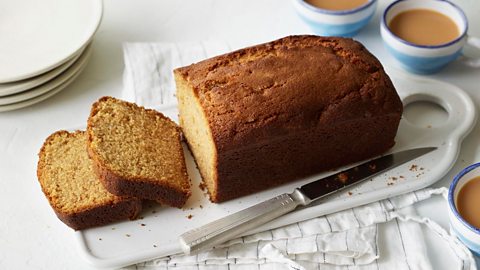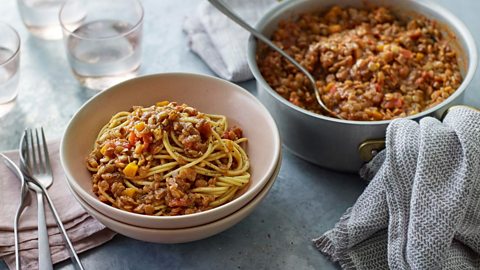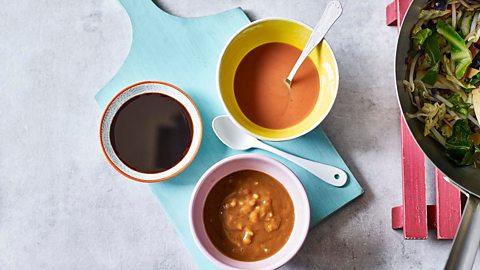How to make the most of breakfast ingredients all day
by Hattie Ellis
Breakfast spreads and sauces have a kitchen life beyond toast and fry-ups and are a great budget staple of cupboard cooking. Use your favourite pots to put a big dollop of flavour in both sweet and savoury dishes. Here are five all-day breakfast stars always on hand to flavour-bomb your food.
Marmalade
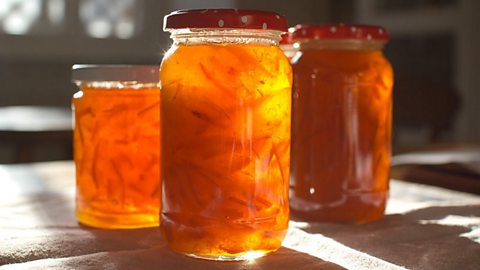
Like jam, marmalade brings fruity flavour as well as sweetness to your cooking, going especially well with anything that benefits from a hit of citrus or touch of bitter, like this bread and butter pudding. For savoury dishes, a spoonful of orange marmalade is great in a beef stew and it partners salty or rich meats – try it in a bacon sandwich, or as a glaze for baked ham or chipolatas.
Make the most of marmalade in sweet foods by adding it to flapjacks, brownies, the buttercream for a sponge, steamed puddings – and a dish that surely warms up winter: marmalade and sherry pancakes, advises Pam-the-Jam Corbin in her The Book of Preserves.
You can make the most of the shredded citrus in marmalade in any bake that uses candied peel, such as hot cross buns and fruit cake. Add it to mincemeat, or my ginger cake, which pairs the warmth of spices with citrus brightness, or a carrot cake.
And you can drink marmalade too. A so-called Breakfast Martini can be made with or without booze, as recommended in Fiona Beckett’s How to Drink without Drinking. Over ice, shake together marmalade with gin or an alcohol-free gin alternative, orange juice, lemon juice and sugar syrup. Strain and add a drop of bitters if you like.
Yeast extract such as Marmite
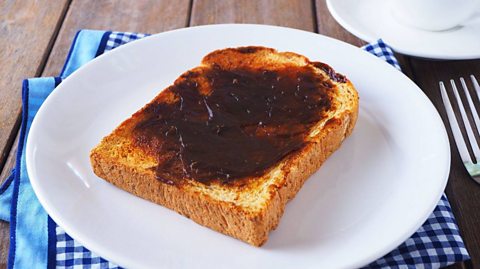
Yeast extract is one of the most useful pots for cupboard cooking – and you don’t have to “love it or hate it”, as the slogan for Marmite goes, because you don’t specifically taste it when it’s used as a seasoning. Even a small amount is a great budget way to impart a deep umami flavour to stews and soups, adding oomph to vegetarian dishes in particular, such as my lentil bolognese. I once went into the kitchen of a Balti restaurant in Birmingham and discovered a catering pot of Marmite that was part of the flavouring of meat and veggie curries, so it works in a range of cuisines.
This dark, mysterious substance is a by-product of the brewing industry (a concentrated paste of excess yeast) and has become a cult ingredient amongst Michelin-starred chefs, bakers and home cooks. Nigella’s Marmite spaghetti, taken from the doyenne of Italian cooking Anna Del Conte, is one of her most celebrated recipes, serving spaghetti with a sauce made from melted butter, Marmite and pasta water – budget cupboard comfort food at its finest.
Sprouts aren’t just for Christmas and cooks are discovering the trick of tossing them with yeast-extract butter. Or take Marmite-on-toast to the next level: bakers now put yeast extract into bread doughs, and a small scrape adds bite and character to a Cheddar cheese toastie or an old-fashioned tomato sandwich.
Be careful not to add too much of this powerful paste – ½–1 teaspoon is enough for a panful of food for four – and if you go too far, add a squeeze of lemon juice to counteract the saltiness.
Honey

Winnie-the-Pooh’s top pot is a versatile ingredient that will glaze, drizzle and season as well as sweeten meat, fish and veg. Honey tastes sweeter than sugar, and just a small amount works a subtle magic in a sauce – try it in a vinaigrette to dress vegetables or a salad that uses salty ingredients such as olives or bacon, in a stir-fry sauce, or in a mayonnaise to make it extra good in a chicken sandwich or with salty chips.
I love to make a salted Honeyscotch sauce as an easy treat. In a small saucepan over a gentle heat, stir and melt together 50g/1Вѕoz each of unsalted butter, soft brown sugar and honey with 125ml/4fl oz double cream. Bring to the boil and bubble for a minute to thicken, then stir in Вј teaspoon flaky sea-salt. Serve hot or warm with ice cream or stewed fruit.
Honey is a favourite ingredient of cooks around the world. Moroccans use it to sweeten a tagine, bolstering and balancing the sweet-and-sourness of tomatoes in particular, and the same trick works in a tomato pasta sauce. The Italians and Greeks drizzle it over cheese.
This natural preserve has been a staple for centuries – the ancient Romans paired it with fish sauce to add sweetness to the savoury saltiness; a little honey melted into a stew with a tin of anchovies works in the same way. It also balances spice heat, for instance in a sauce paired with mustard or chilli.
To measure out honey neatly and efficiently, first dip your spoon into just-boiled water, or measure out oil beforehand, to help the sticky stuff slide off cleanly.
Peanut butter
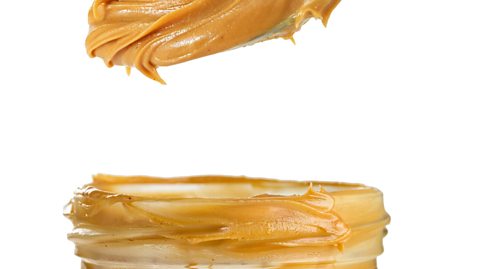
Salty peanut butter is classically paired with sweetness in the American peanut-butter and jam sandwich. More substantial savoury dishes play around with this idea, with Asian recipes adding hot and sour too. Indonesian satay sauce, be it for chicken, pork, aubergine or tofu, mixes peanut butter with garlic, chilli and soy sauce. My peanut butter chicken is an easy family meal, with a sauce rich with similar ingredients, plus coconut milk and lime juice.
Peanut butter is useful for adding inexpensive body, protein and flavour to bakes – and texture if you use the crunchy kind. Look out for it in recipes for cookies (including flourless cookies), brownies, blondies and cheesecake. Nigella’s chocolate peanut butter cake is one of the hits of her recent ґуПуґ«ГЅ TV series Nigella’s Cook, Eat, Repeat.
Want a DIY challenge? You can make your own peanut butter by roasting peanuts in the oven until golden. Cool, then blend with salt and oil until the consistency is to your liking.
Ketchup

This tangy condiment adds a sweet-and-sour element to many simple and inexpensive dishes beyond a bacon butty. It piles flavour and sweetness into a sticky BBQ sauce, mixes well with soy sauce and sesame oil for sweet-and-sour sauce, and can be added to subtly season a meat or veggie bolognese.
Ketchup pairs well with seafood if used in moderation. Best known for putting the pink into a Marie-Rose prawn cocktail sauce (also delicious on a lettuce-based salad or in a sandwich), a quick shake also gives a welcome touch of tomato to white sauce for a fish pie.
Posh ketchups tend to be well-flavoured with an array of spices, such as tamarind, cloves, mustard seeds, allspice and chilli. A quick shake instantly seasons a meatball sauce, or add to a base for homemade baked beans or to bolster other bean recipes that use tinned tomatoes.
The wonders of ketchup aren’t just for the savoury. Some cooks use it – in careful quantities – in sweet dishes. It goes into chocolate cake and rich, chilli-infused chocolate pots in Florence Knight’s book One: A Cook and her Cupboard (1 tablespoon per 100g/3½oz dark chocolate – or try ½ tablespoon to see if you like the idea), adding a berry-like sweet acidity to the mix. It’s not for everyone, however, and best enjoyed when you don’t know the saucy source.
Originally published January 2021
